

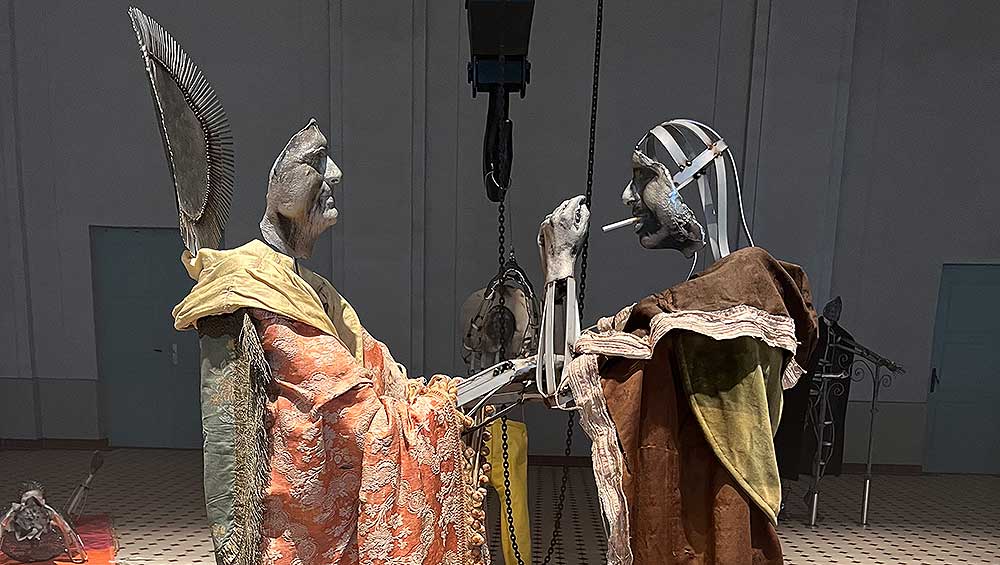
Kira Freije. Vocabulary of ruin and the divine wound, 2023 (detail). Stainless steel, cast aluminium, silk, velvet, wool, cigarette. Photo: Veronica Simpson.
by VERONICA SIMPSON
You could say Kira Freije’s works are haunted - haunted by the presence and absence of spirit and flesh. Their faces, cast from the faces of her loved ones, are preserved for ever in aluminium, in the moment of casting, while the originals will age and weather. Their bodies are ghosts, sketched into presence via eloquent yet minimal bands of metal. The slender corsets that Freije constructs conjure arms, legs, bums and torsos. Their manufacture and material speak of the foundry, of industry, which somehow evokes more vividly the emotional, physical presence of whoever or whatever inspired and shaped them – ethereal, mutable, unknowable.
Freije was born in 1985 in London and studied at the Ruskin School of Drawing and Fine Art at the University of Oxford, before graduating with an MFA from the Royal Academy Schools in 2016. The Throat Is a Threaded Melody at E-Werk Luckenwalde, her first solo show outside the UK, is her most ambitious and significant show to date. Five intense months of production have yielded all new works, placed judiciously around the Turbine Hall in a decommissioned power station in the former East German town of Luckenwalde – a town that still looks and feels as if it is stuck in Germany’s pre-unification, Soviet era. Freije collaborated with lighting experts from Matt Daw Lighting Design for the exhibition and her figures are stroked by sunbeams that filter down through the enormous ceiling grid, travelling in the opposite direction from the smoke that used to soar upwards from the coal furnaces. These moving “fingers of light” animate a strategic layer of soft and shifting haze.
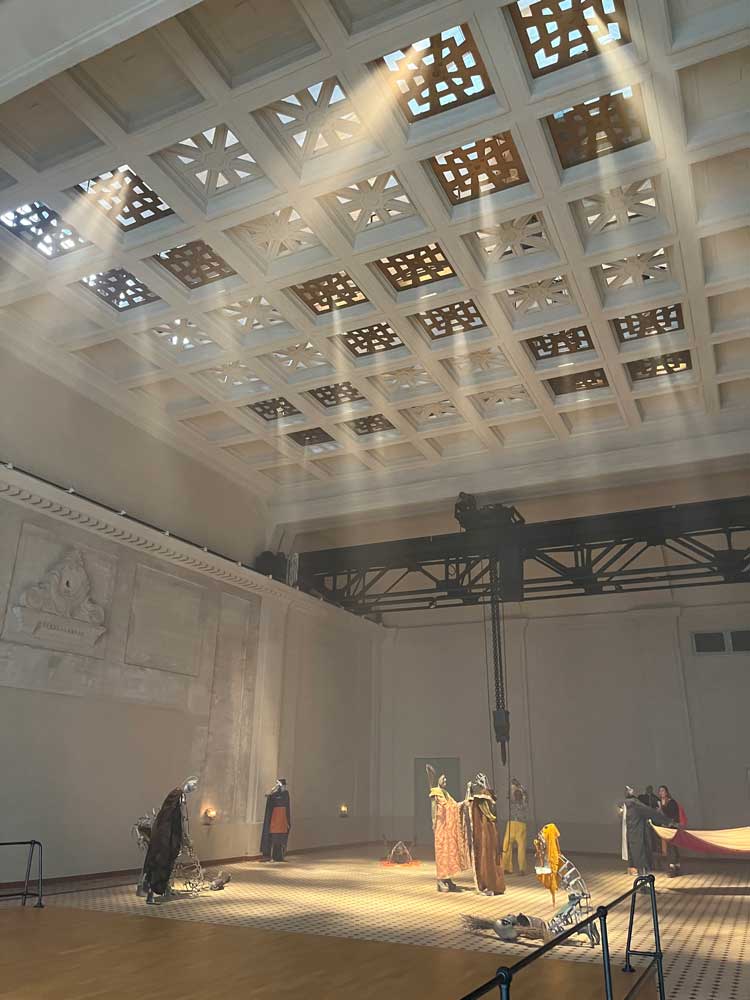
The Turbine Hall at E-Werk Luckenwalde, lit by Matt Daw Lighting Studio. Photo: Veronica Simpson.
Since completing her BFA at the Ruskin, Freije’s predominantly metal sculptures have gone through several shifts. Her early slender pieces, framing words and worlds, have shifted slowly but surely towards the figurative, combining cold-formed metalwork with sand-cast aluminium. In the E-Werk Luckenwalde show the narratives behind these figures are further fleshed out with costumes and props, and palpable dramatic tension emanates between the figures as well as between the works and this magnificent space. One hangs its weight backwards off a giant metal hook – are they playing or resisting? Themes of power and submission hover around every figure or grouping. Two statuesque characters in antique robes instantly draw the eye from the doorway, in particular one whose beaten-metal headdress casts a halo above it, albeit one fringed with blunt spikes. Its title, Vocabulary of Ruin and the Divine Wound amplifies the sense of drama and is typical of Freije’s poetically named pieces (all the works here were made in 2023). As you approach this pair from the rear, there is a suggestion of some liaison or conversation between church dignitaries, but turn a corner and it is clear that the character in the headdress is top dog, his companion subservient but also subversive - lighting a cigarette as he leans in (to drop some delicious piece of gossip into his companion’s ear?). His inclined form draws your eye down towards the high heels and platform soles on the cardinal’s feet. Nothing is quite as it seems in Freije’s world. There is a strong sense of mystery, augmented by the light playing across the room, making the absence of flesh, the gaps in their bodies, as well as the imagined emotions and actions, even more intriguing.
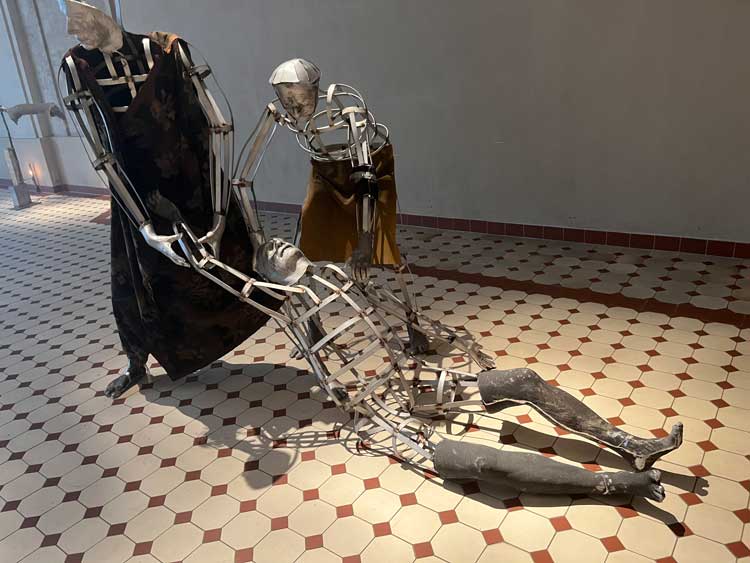
Kira Freije. Trudging, the sodden prelude, 2023. Stainless steel, cast aluminium, wool, suede, hide, 170 x 75 x 243 cm. Photo: Veronica Simpson.
This is certainly true of the figure being dragged across the floor in the middle of the room (Trudging the Sodden Prelude), or the freshly landed paratrooper (Falling Hours) – a small, metal “parachute” trailing from him by slender strings – who sits at the far end, in what looks like a boxing ring. But there is also playfulness, ease and relaxation in the figure on the floor, near the door (Between Sunlight) – stretched out on its stomach, legs kicking back, blowing into what appears to be a flaming crown of metal, but lying on fabric that is something between a beach towel and an unravelled straitjacket (loose bindings flare around it).
Freije’s recent exhibitions include River by Night at Cample Line, Scotland; Trickster Figures at MK Gallery Milton Keynes; Meteorites at the Approach, London; To the River at Gianni Manhattan, Vienna; Far Back Must Go Who Wants to Do a Big Jump at ChertLüdde, Berlin; and Mouthing the Living, Undetected, on Breeze or Breath, at Soft Opening, London.
Studio spoke to her in person at the opening of the show at E-Werk.
Veronica Simpson: What a fantastic setting for your work. How well did you know it before you started planning what you would make?
Kira Freije: I’ve been here once before: I didn’t know I was going to have a show then. I came in 2019, when they had just opened. I was in Berlin doing a group show at ChertLüdde, and I knew Helen [Turner, co-director of E-Werk Luckenwalde].
A few months after that she asked if I would like to have a show here. It was a dream. It was supposed to happen in 2020 and originally meant to be in one of the smaller galleries and then I managed to be in this space. Obviously, they’re all beautiful spaces, but this is a very unusual space and I’ve never had the opportunity to make work for somewhere of this scale.
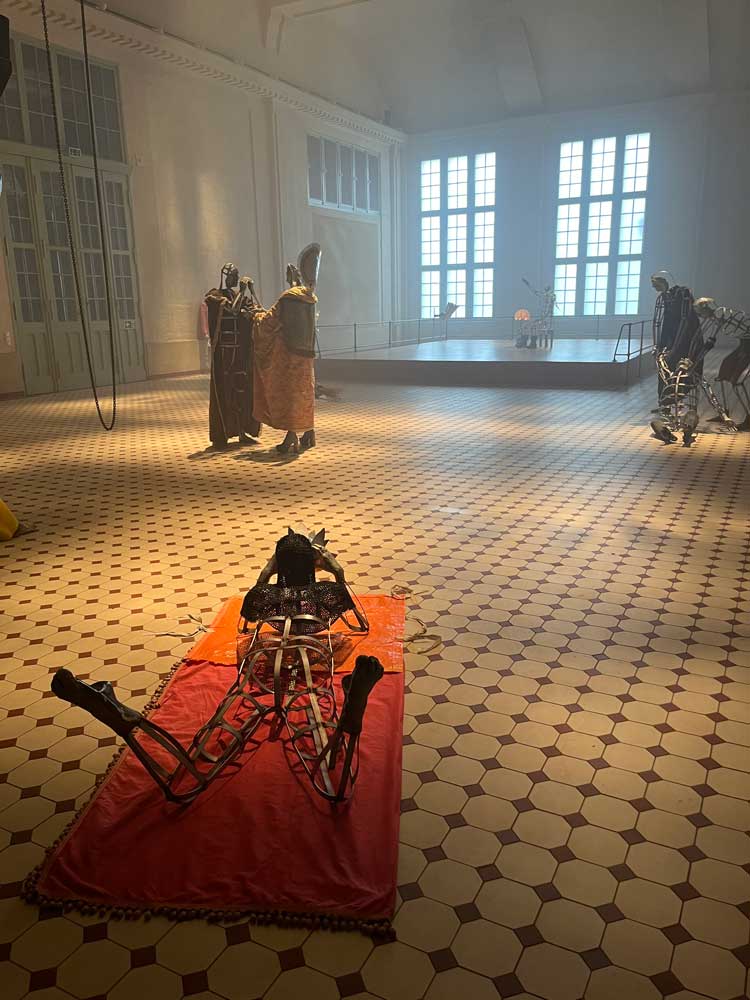
Kira Freije: The Throat Is a Threaded Melody, installation view, E-Werk Luckenwalde, 2023. Photo: Veronica Simpson.
VS: The lighting is spectacular.
KF: I’ve always wanted to before but, here, I’ve worked with lighting designers. We have designed the inverse of what used to happen here, in the Turbine Hall, where the smoke would go up through these grates in the ceiling. Now the shards of light come down from the ceiling, but we use the grates up there to dapple it.
VS: As a fan of contemporary theatre and dance, I feel lighting design today is one of those great unsung arts.
KF: I’m not sure I’ll ever do a show without them. They’re amazing. It’s always the last thing you think about in the show.
A friend of a friend put me in touch with Matt Daw. He’s currently in Stratford-upon-Avon doing Cymbeline, I think, but he does stuff for [the US film-maker] Wes Anderson. He’s doing Alicia Keys’ tour next, and Björk’s world tour. And he wanted to do it. He was really excited about this space. Because I knew my work would be predominantly figurative, I think that was an interesting proposition for someone who works in theatre as well. You can see the light is just slightly changing, as if clouds were passing.
VS: If you don’t know about lighting design, how do you brief your lighting designers?
KF: We went through lots of briefs. I said I don’t know anything about lighting, so I don’t really know what to tell you except for the fact that this is kind of what I want. I described Grand Central Station, but also the foundry where I get all my aluminium cast, which has amazing light, but the windows are so caked with the sand and grime of years that you get an amazing orange dappling coming through. We were talking also about very slow washes of natural light – theatrical, but without the colour. And the impossibility is that I want it to still be daylight. It was very seductive when it was dark – originally the windows were blacked out - but it’s stranger somehow and more like the original intention in this atmospheric world to have filtered daylight … it’s that kind of industrial atmosphere and a place of motion as well.
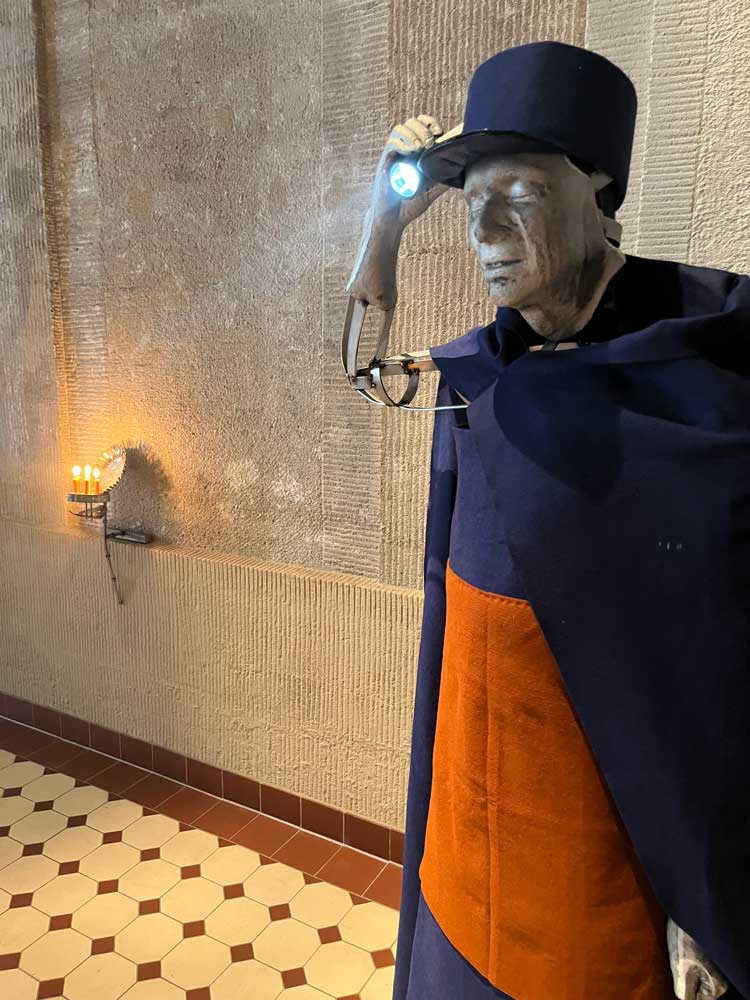
Kira Freije. Remorse the violent whisper, 2023. Stainless steel, cast aluminium, felt, leather, torch, 173 x 272 x 30 cm. Photo: Veronica Simpson.
VS: There is a sense of powerful dialogue between presence and absence in your work, especially with the ghostlike remains of your friends behind the cast faces, or within the body frames. I love the idea that you have taken this haunted, temporally ambiguous aspect a step forward with these tableaux. You can really imagine the interactions that inspired or sparked you. There’s so much invisible stuff going on.
KF: Yeah. I want this fading light but with the sense of daylight. I want them to be very much present and interacting in a world with each other but completely interior as well.
VS: Is the incorporation of clothes and props new? I don’t think I’ve seen that in previous work.
KF: I have done that in the past, but I allowed it to come much more to the fore in this group. And I’ve been thinking about the theatricality of it as well. There were years when I was averse to falling into that and now I want it. But there’s a quality of being still in the world of sculpture and staying the right side of it, which is often the struggle with my work anyway because of the materiality of it. I never even really think of myself as a metal sculptor … I just use metal because it’s such a smart material to use. It’s like better cardboard … you can stick it really easily and really well. I have an affinity to it, of course, but there’s a fine line I always have to tread: of staying somewhere strange and interesting to me and not falling towards the kind of technical sophistication of metalworking, which I’m not particularly interested in.
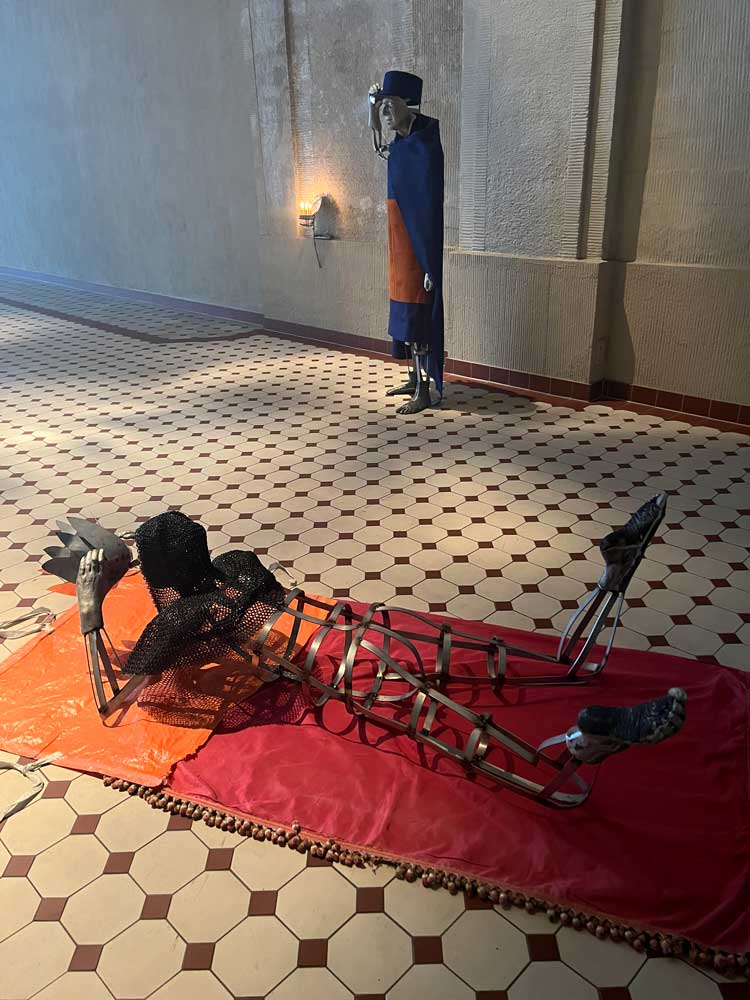
Kira Freije. Between Sunlight, 2023. Stainless steel, cast aluminium, silk, tarpaulin, 57 x 205 x 98 cm. Photo: Veronica Simpson.
VS: These feet are extraordinary, the feet and hands and faces are so utterly lifelike. You cast from life. Do you always use your friends in your work?
KF: Only for the faces. I use my hands and feet and legs, so they become somewhat like combined portraits. And it’s quite nice to think of them like that. But all the faces are people in my life.
I think for quite a long time about whose face will work in an approximation of the idea I have. That’s another thing about working with metal: it allows you to collage in a way, and assemble. I feel more and more like they’re assemblages, even though they’re becoming more specifically figurative. And, hopefully, they feel more like they are in a motion.
VS: I read in an interview that your ideas are often sparked by gestures, and I can see all of that in this room. As well as the stories that you are telling, but also stopping well short of any literal, pictorial representation.
KF: Yes, and that’s the beauty of the materiality. And being put together in my studio, that process allows that to- and fro-ing to happen more and more. There is obviously a story within it, but I also enjoy it when the story can shift one way or another. For me, I’m probably quite impatient or I get bored easily. So, I like to be excited by it, and to not know; to be surprised.
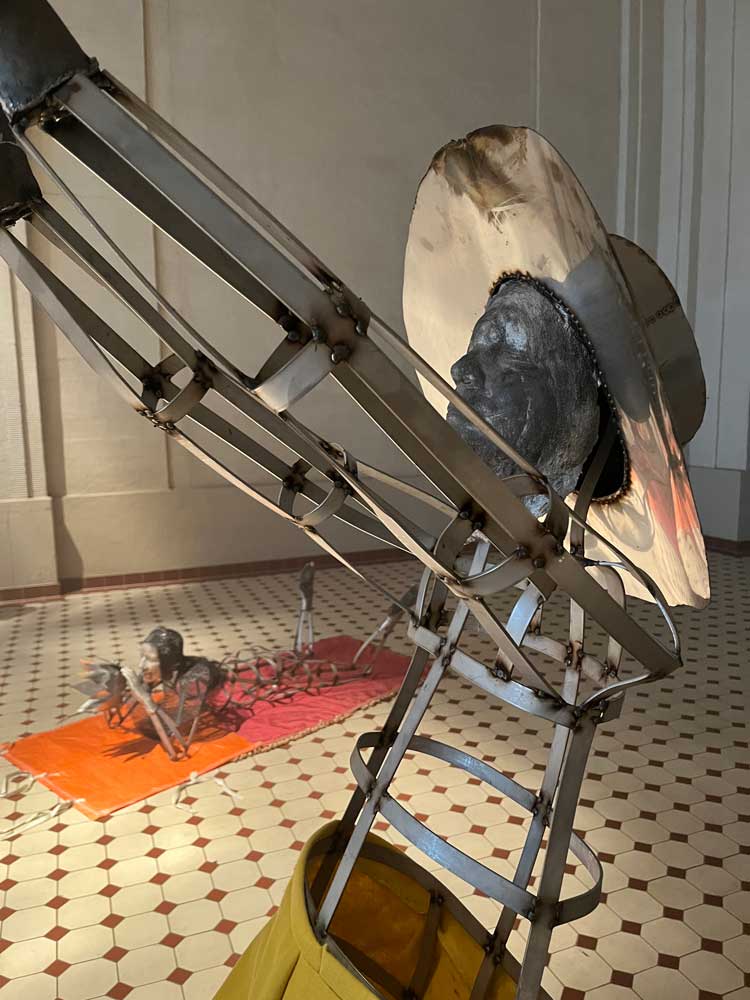
Kira Freije. Scorched Earth, 2023 (detail). Stainless steel, cast aluminum, felt, 183 x 52 x 88 cm. Photo: Veronica Simpson.
VS: In reviews of your work, the word medieval pops up frequently. Looking at the armatures, the metal screens and sconces around them, that makes sense. But the word popping into my head here is baroque.
KF: Yes, I think they are quite baroque. But they also need to be able to shift within time.
VS: That’s always a danger when you use costumes or clothes; it can root the work specifically into a particular story or era. Although I know you have used coloured glass in previous work, this feels like a much richer palette than you normally use.
KF: It feels somehow more akin to painting than I’ve been able to achieve before, and that’s possibly due to having the opportunity to make the largest body of work I’ve ever made in one grouping.
VS: Was there anything you were reading at the time that inspired these works or tableaux?
KF: I’m sure there was. I always start around [TS Eliot’s] Four Quartets.
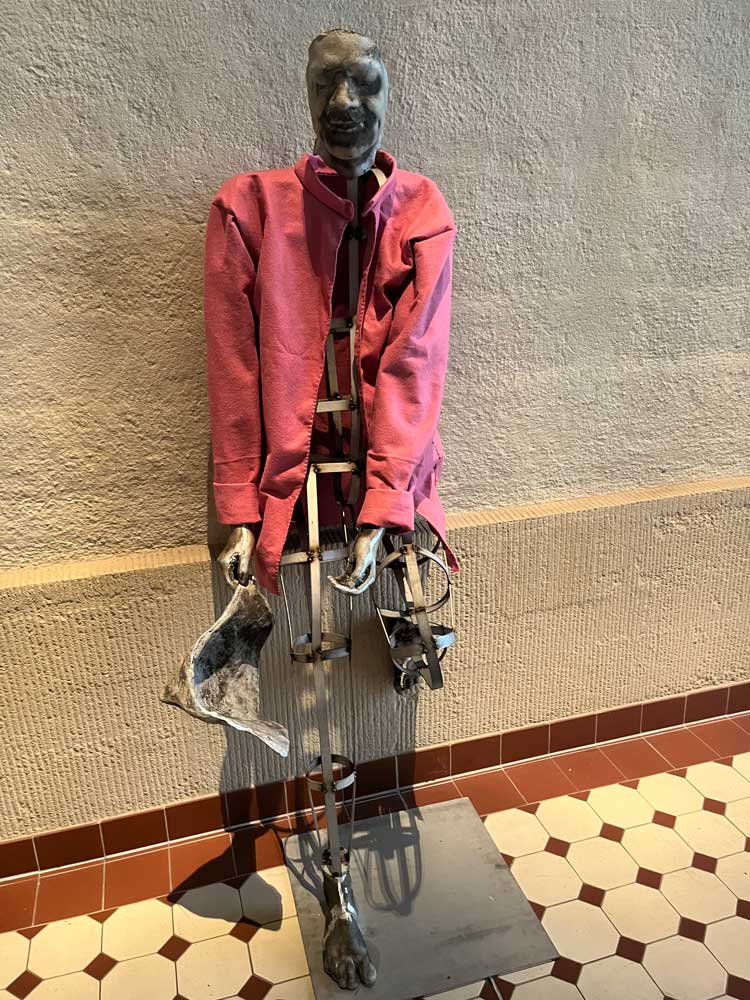
Kira Freije. Temperant observer, 2023. Stainless steel, cast aluminium, felt, 175 x 75 x 68 cm. Photo: Veronica Simpson.
VS: I was going to ask how you incorporate poetry in your practice, as the titles are so evocative, and obviously you were using words in your earlier work.
KF: Yeah, and I collect words as I go along, and in my sketchbook often there are lists of words or sentences and they kind of form a matrix and then get formed into the titles. But, usually, there’s a feel through the words or a collection of words, like materials – like scrap metals or bits I’ve cut and used – it feels again like assemblage in that way. But I also often dip in. TS Eliot … You can’t better it. I listen to him speaking it – you can hear him reading his poems on Spotify. I love that very old-fashioned way of speaking – Received Pronunciation.
I think I was also quite excited by watching The Great Beauty and the Hand of God, both by an amazing Italian director, Paolo Sorrentino.
VS: There is that filmic quality - the way the light works around and through the materials and absence of materials is magical.
KF: Working with Matt Daw, his working partner Johanne Jensen came out here and was putting this together with me. It was really interesting from a curatorial perspective. I thought she could curate my work so well because it is figurative, and because she’s so used to the theatre. She knew I wanted some haze but not masses of it. There’s a low level of haze. Regarding the positioning, I’ve moved things around a lot with Helen [Turner] as well.
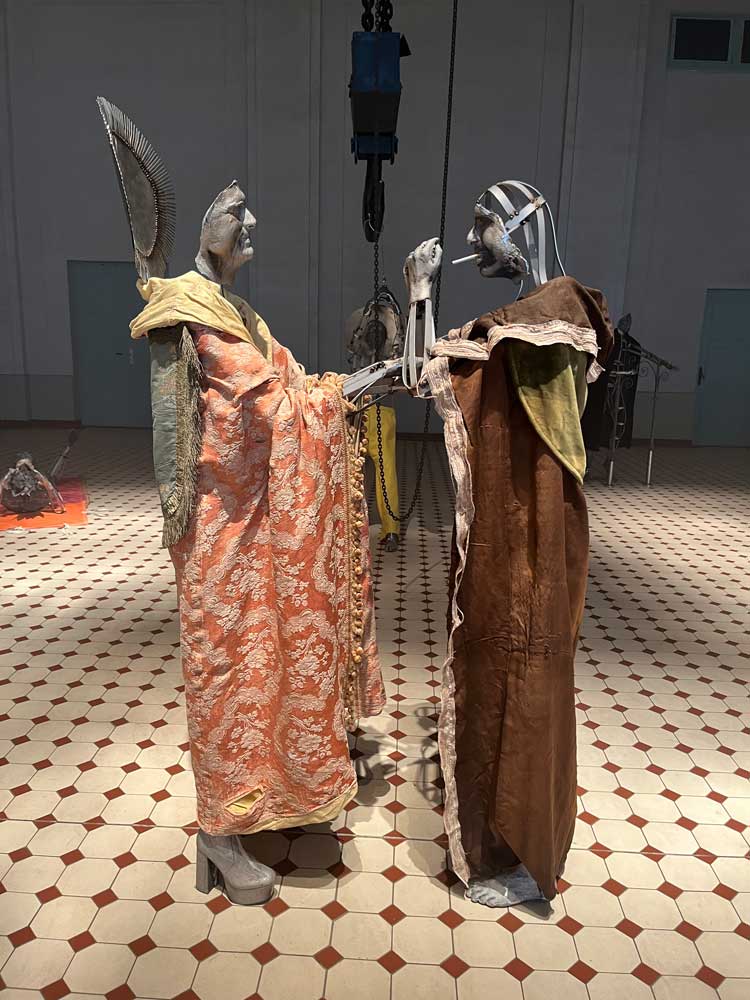
Kira Freije. Vocabulary of ruin and the divine wound, 2023. Stainless steel, cast aluminium, silk, velvet, wool, cigarette. Photo: Veronica Simpson.
With this work (Vocabulary of Ruin and the Divine Wound), I think these two I’m particularly excited by and they’ve allowed me to be a bit more playful. Some of the fabric was sun-stained over a few months but some is antique, 18th or maybe 17th century, and I’ve used the lining from the garment in this work over there (she gestures to a nearby figure). There are often little mimics of shapes within the sculptures.
VS: Tell me about the booklet that comes with the exhibition. The writer Vanessa Onwuemezi has responded to each of the works.
KF: Vanessa is one of my best friends. We lived together for the three years of my undergraduate degree (at the University of Oxford) when Vanessa was studying biology and I was at the Ruskin. She’s one of my best friends and we’ve collaborated a few times before. Because she is such a close friend, she’s one of the only people I let into my sketchbook. She’s come to my studio maybe three times in the process of making this, and took photos of my sketchbook and words, a few little words or ideas around the works make their way in (to her poems). She’s an incredible writer. Her collection of short stories, Dark Neighbourhood, was published by Fitzcarraldo a few years ago. She’s a very talented writer, and just happens to be one of my best friends and wants to be collaborative in the way we work together.

Kira Freije. Trudging, the sodden prelude, 2023. Stainless steel, cast aluminium, wool, suede, hide, 170 x 75 x 243 cm. Photo: Veronica Simpson.
VS: The Ruskin is an unusual art school in that you can mix many other disciplines in with your art practice – sound design, or physics, as Oliver Beer did there.
KF: I was so lucky to go there. The RA was probably even more liberating, it was so freeing without the academia. It was much more emotional there, or it was for me. There, you’re given permission to shed the kind of art-historical shackles. And there are so few of you. I had space for the first time, I had free rein of the metal room. I could just … do what I wanted. I was very lucky to go there.
VS: Your work with metal has evolved quite significantly over the last decade.
KF: Yes, I was already working with metal at the Ruskin, but with a post-minimalist aesthetic, trying to make it perfect, with just traces, very light touch. But I became very bored with myself. And … I didn’t have a studio when I left, and then the local blacksmiths let me go in there and make stuff for a show I had, over a few months.
VS: How was that: moving from a studio art space to a sweaty, dirty, noisy blacksmiths?
KF: I’m quite tidy in my studio, quite health and safety conscious. So, it was really good for me to have that contrast. I have used metal ever since school. I’ve always been very drawn to it, and I can’t give you any hugely symbolic reason why.
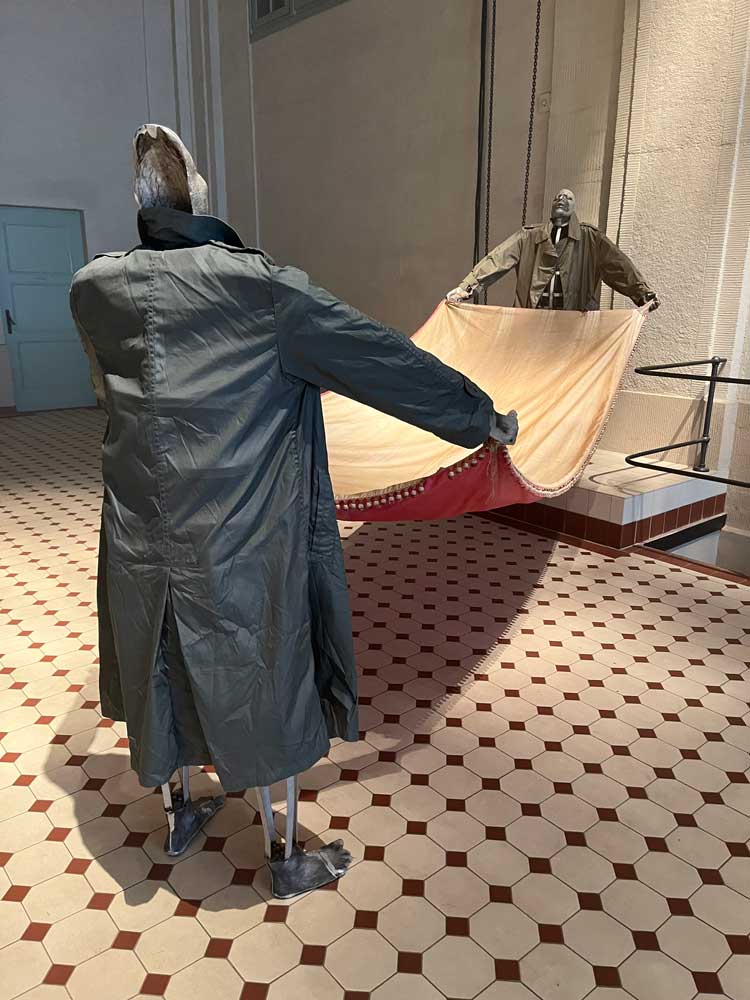
Kira Freije. Unspeak the chorus, 2023. Stainless steel, cast aluminium, silk, cotton, 174 x 410 x 129 cm. Photo: Veronica Simpson.
VS: In the last few years, you have been moving along a more figurative arc. From what I’ve read, you didn’t see it coming. Where on that arc do you think you are right now?
KF: Hmm. I don’t know. I’m into it at the moment, fleshing it out. It feels as if there’s more to do. And this has been a really enjoyable body of work to make - quite gruelling, but really enjoyable. It took about five months with very few days off. It has been something I realise I’ve wanted to do, to make a fully figurative show without it being overly narrative, and I think I’ve hopefully done it. I think I’d like to do a bit more.
VS: Now that you have exhibited in a 20th-century power station, is there any other architectural space to which you would like to take this work? I could see it in Venice; in a historic, religious setting it would look fabulous.
KF: I would like to take this group somewhere … Venice would be amazing. But I would also like to start another group.
• Kira Freije: The Throat Is a Threaded Melody is at E-Werk Luckenwalde until 16 July 2023.